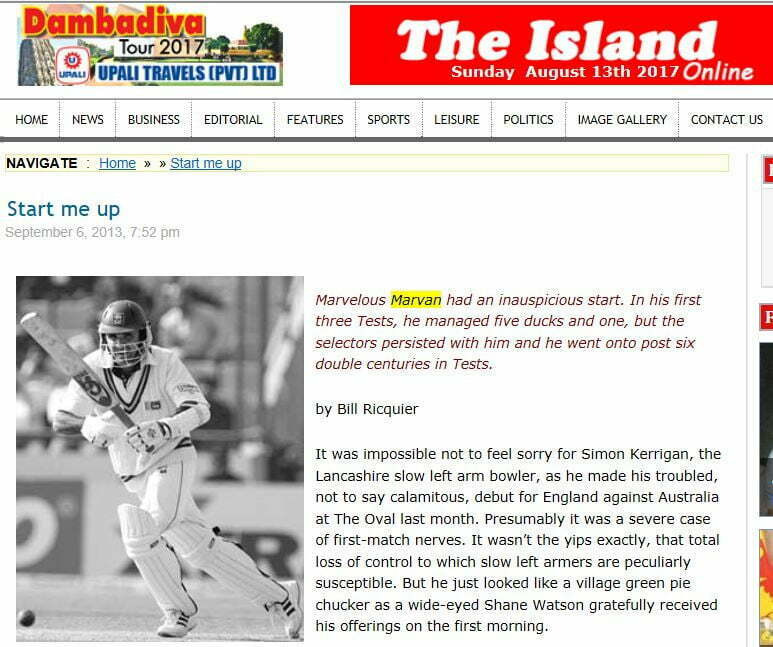It was impossible not to feel sorry for Simon Kerrigan, the Lancashire slow left arm bowler, as he made his troubled, not to say calamitous, debut for England against Australia at The Oval last month. Presumably it was a severe case of first-match nerves. It wasn’t the yips exactly, that total loss of control to which slow left armers are peculiarly susceptible. But he just looked like a village green pie chucker as a wide-eyed Shane Watson gratefully received his offerings on the first morning.
Perhaps he was still suffering from the after-effects of shock at the discovery of his selection. That certainly seemed to be the reaction of most observers to the inclusion of Kerrigan and Chris Wookes in the final eleven.
All that can be said is that it is inconceivable that a side with genuinely ambitious intent; the West Indies or the Australians in their heyday or Graeme Smith’s South Africans, for instance – would have let their opponents off the hook in the same way. The England selectors in picking Kerrigan seemed more interested in sending a message to the hapless Monty Panesar than in picking a side to beat the Australians. (The fact that thanks to Michael Clarke’s final day tactics England almost won the match is irrelevant.)
But that is not the point. The point is, is that it as far as Kerrigan and Test cricket are concerned?
Is a Test debut more difficult for a bowler than for a batsman? That is not an easy question to answer. Conventional wisdom has it that the worst thing that can happen to a batsman is to be out first ball. You make the long walk from the pavilion to your crease, take guard, examine the field, shuffle into you stance, await your first delivery, make the necessary movements and then; ouch, what’s that sound? You turn to observe the wreckage of your stumps and then take the slightly longer and distinctly lonelier walk back to the pavilion. The whole thing takes about two and a half minutes. And then you are out of the public eye, until it is time to field.
For a bowler, it’s a bit different. If your first ball, blameless, but unthreatening, is lofted over the sightscreen for six, you can’t just go off and have a bit of a re-think and come back when you are feeling better. You have to get through that over and then a few more after that.
And getting a duck is not necessarily so bad. After all, anybody can be out first ball. Mark Benson, the Kent opener who became an international umpire, played one Test, against India in 1986. He made 21 and 30. Later, he said he would have been better off bagging a pair. Then people would not have realised how uncomfortable he was at Test level.
The former Sri Lankan opener Marvan Atapattu had a tortuous introduction to Test cricket. He made his debut against India at Chandigarh in November 1990. He bagged a pair batting at seven. His next game was against Australia at Colombo in August 1992, the game where Allan Border, apparently almost in desperation threw the ball to his young leg-spinner Shane Warne, who took the last three wickets in for no runs in thirteen deliveries.
Atapattu, still in the middle order made nought and one. He toured India again in 1993-94 and played at Ahmadabad where he again bagged a pair. On the Benson theory it could perhaps be argued that the selectors had not had a proper chance to assess him but this looks like an extreme case.
In 1996-97, he made 25 and 22 against New Zealand, nought and 25 and 14 and four against Pakistan and seven and ten against the West Indies. By this time he was batting at number three.
Atapattu’s next Test, against India in Colombo in 1997-98, was littered with statistical landmarks. Sri Lanka made the highest score in Test history (952 for six). Sanath Jayasuriya made the highest individual score in a Test against India (340). Roshan Mahanama made what was at that time Sri Lanka’s third highest Test score (225 not out).
And Atapattu opening with Jayasuriya, made the then highest Test score of his, (26).
In the return series in India four months later, Atapattu finally broke through. Opening the batting clearly suited him; all those early failures had been in the middle order facing spinners. On this third tour of India, when he had previously failed to make a Test run, he made a hundred on the opening day of the first Test at Mohali. It was his tenth Test. He never looked back. He finished with six double centuries; only Bradman, Lara, Hammond and Sangakkara have made more.
Bill Ricquier, 06/09/2013
This article was published in The Island: http://www.island.lk/index.php?page_cat=article-details&page=article-details&code_title=87465
Share this Post
